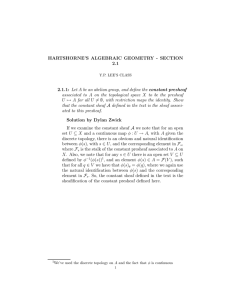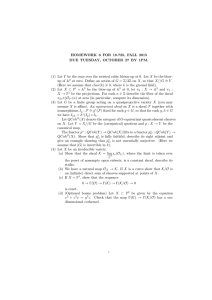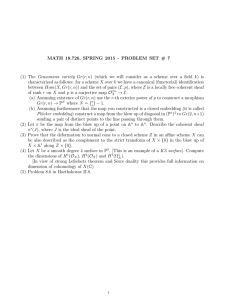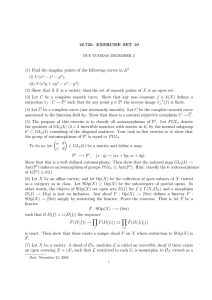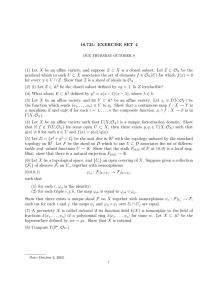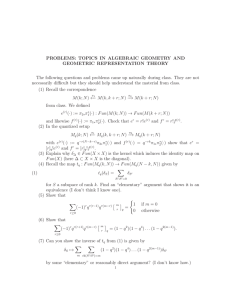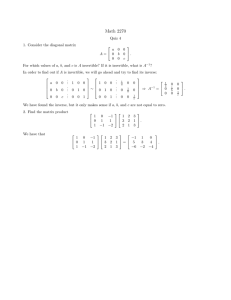INTRODUCTION TO ALGEBRAIC GEOMETRY, CLASS 24 Contents
advertisement
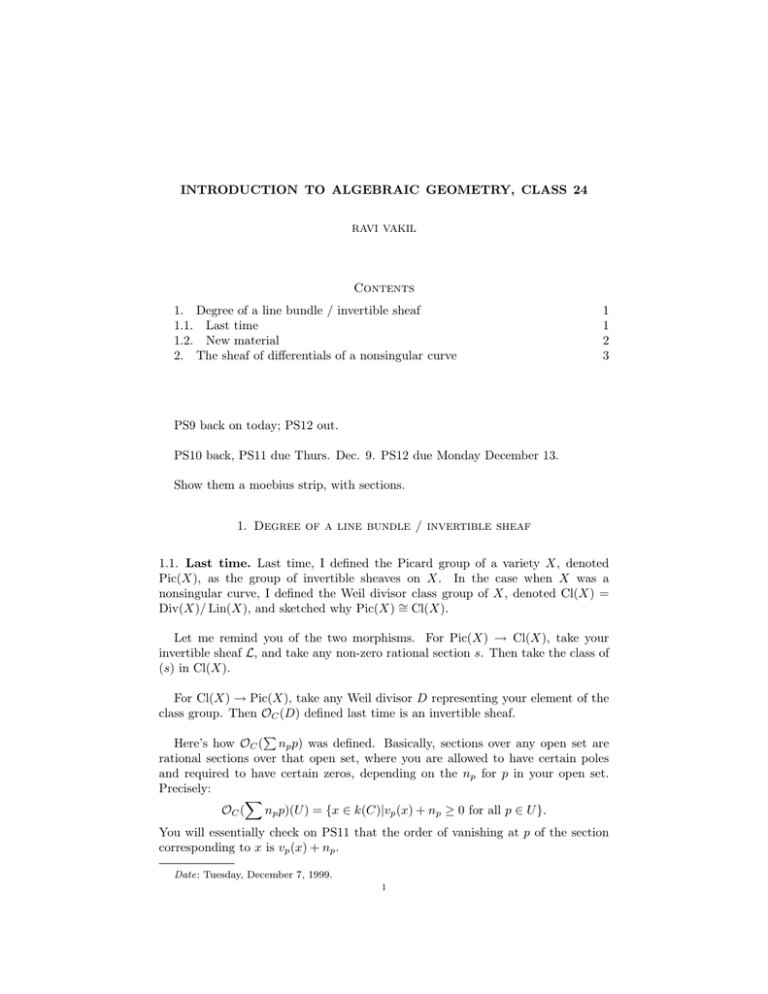
INTRODUCTION TO ALGEBRAIC GEOMETRY, CLASS 24
RAVI VAKIL
Contents
1. Degree of a line bundle / invertible sheaf
1.1. Last time
1.2. New material
2. The sheaf of differentials of a nonsingular curve
1
1
2
3
PS9 back on today; PS12 out.
PS10 back, PS11 due Thurs. Dec. 9. PS12 due Monday December 13.
Show them a moebius strip, with sections.
1. Degree of a line bundle / invertible sheaf
1.1. Last time. Last time, I defined the Picard group of a variety X, denoted
Pic(X), as the group of invertible sheaves on X. In the case when X was a
nonsingular curve, I defined the Weil divisor class group of X, denoted Cl(X) =
Div(X)/ Lin(X), and sketched why Pic(X) ∼
= Cl(X).
Let me remind you of the two morphisms. For Pic(X) → Cl(X), take your
invertible sheaf L, and take any non-zero rational section s. Then take the class of
(s) in Cl(X).
For Cl(X) → Pic(X), take any Weil divisor D representing your element of the
class group. Then OC (D) defined last time is an invertible sheaf.
P
Here’s how OC ( np p) was defined. Basically, sections over any open set are
rational sections over that open set, where you are allowed to have certain poles
and required to have certain zeros, depending on the np for p in your open set.
Precisely:
X
OC (
np p)(U ) = {x ∈ k(C)|vp (x) + np ≥ 0 for all p ∈ U }.
You will essentially check on PS11 that the order of vanishing at p of the section
corresponding to x is vp (x) + np .
Date: Tuesday, December 7, 1999.
1
1.2. New material. Assume from now on that C is projective (and still nonsingular). In this case, we can define the degree of an invertible sheaf. The key technical
result is:
Theorem. Suppose s is a non-zero rational function on C. Let (s) =
P
Then
np = 0.
P
p∈C
np p.
Notice that we earlier proved this result when C = P1 . This theorem is not too
tricky, but for the sake of time, I’ll omit the proof. Let’s look at its consequences.
Definition
/ Easy
P Proposition. Define the degree function deg : Div → Z,
P
np . Then for D ∈ Lin, deg D = 0 (the theorem). Hence deg
by deg( np p) =
descends to give a function deg : Cl(C) → Z and hence deg : Pic(C) → Z.
If you unwind the identification of the Picard group and the Class group, you
get the following recipe to calculate the degree of an invertible sheaf L: find any
non-zero rational section, and calculate find the sums of the orders of its zeros (and
poles).
Example (not on problem set). Use this recipe to check that OP1 (2) has degree
2.
Suppose L were an invertible sheaf with a non-zero section s. Then this section s
would have no poles, and possibly some zeros, so its degree would be non-negative.
Moreover, if s had no zeros, then it would be invertible, so L would be the trivial
sheaf. Hence:
Proposition. An invertible sheaf of negative degree has no non-zero sections.
An invertible sheaf of degree 0 has no non-zero sections unless it is the trivial sheaf,
in which case it has a one-dimensional family of sections.
Proof. All that’s left to prove is that the trivial sheaf has precisely a onedimensional family of sections. In other words, C has a one-dimensional vector
space of regular functions, the constants. This will follow from the next result.
Proposition. Let C be a nonsingular projective curve. Then there are no
nonconstant regular functions on C.
(You proved this when C = P1 .)
Proof. Suppose s were a nonconstant regular function on C. Let p be a point
on C, and suppose s(p) = a ∈ k. Then s(p) − a is another nonconstant regular
function, and it has a zero at p. Hence its divisor (s − a) has at least one zero and
no poles, which has positive degree. But this is a rational function with positive
degree, contradicting our Theorem.
2
2. The sheaf of differentials of a nonsingular curve
I’m going to describe this sheaf in a down-to-earth way. The best way to understand this sheaf is very explicitly. The best way to prove things is by describing it
very abstractly. So I’ll prove fewer things in the hope that you’ll still understand
what’s going on. What I’d most like is for you to be able to calculate things.
Cotangent line bundle (= the sheaf of differentials).
Definition of this sheaf. On an affine variety, say what it is: Ω1 (U ) is the A(U )module generated by ds where r, s ∈ A(U ). Rules: ds = 0 if s ∈ k. d(r + s) =
dr + ds. d(rs) = rds + sdr.
Exercise. r ∈ A(U ). Show d(rn ) = nrn−1 dr if n ≥ 0. If r ∈ A(U )∗ , i.e. r is
invertible, dr n = nrn−1 dr.
Proposition. This is a finitely-generated module generated by dx1 , . . . , dxn ,
where xi are generators of A(U ).
Proof. ds(x1 , . . . , xn ) =
Pn
∂s
i=1 ∂xi dxi .
Example. If U = A1 with coordinate x, then the global differentials on U are of
the form f (x)dx where f (x) ∈ A(U ) = k[x]. Clearly it is an A(U )-module. dx is
the generator of this module. It doesn’t vanish anywhere.
If the variety is a nonsingular curve, this describes an invertible sheaf. I’ll make
this precise soon; assume it for now. But I first want to make some calculations, to
show you that they are reasonable and straightforward.
I won’t explicitly explain why it is a sheaf, but I’ll wave my hands in that
direction. The following proposition will show how restriction maps from affines to
distinguished opens work.
Proposition. Ω1 (D(f )) = Ω1 (U )f .
More precisely: there is a canonical isomorphism.
Proof. Suppose A(U ) is generated by x1 , . . . , xn as an algebra. Then Ω1 (U ) is
generated by dx1 , . . . , dxn as an A(U )-algebra.
Now A(D(f )) = A(U )f = A(U )[1/f ] is generated by x1 , . . . , xn , 1/f as an
algebra.
Ω1 (D(f )) is generated by dx1 , . . . , dxn , d(1/f ) = −(1/f 2 )df ∈
A(D(f ))-algebra. This is isomorphic to Ω1 (U )f (explain).
3
1
1
f 2 Ω (U )
as an
The restriction map Ω1 (U ) → Ω1 (D(f )) is just the inclusion Ω1 (U ) ,→ Ω1 (U )f .
Remark. This description is the cotangent sheaf ΩX/k for any scheme X. Not
invertible sheaf in general; it is a coherent sheaf, whatever that is. Note that it is
an OX -module. Vector bundle if X is nonsingular. Dual to tangent bundle. The
dualizing or canonical sheaf in that case is the top wedge power of the cotangent
sheaf. Exercise. Calculate Ω1Pn .
In the case we’re interested in, that of a nonsingular curve, this sheaf is actually an invertible sheaf. I’ll wave my hands about that in a moment. But first,
calculation:
Proposition. Ω1P1 ∼
= OP1 (−2).
Proof. Assuming that Ω1P1 is an invertible sheaf, we need only find a non-zero
rational section and calculate its degree.
Once again, let’s set out our coordinates. Let [x0 ; x1 ] be projective coordinates
on P1 . Let y1 be the coordinate on standard affine U0 , so [x0 ; x1 ] = [1; y1 ]. Let z0
be the coordinate on standard affine U1 , so [x0 ; x1 ] = [z0 ; 1]. Hence y1 = x1 /x0 ,
z0 = x0 /x1 = 1/y1 .
Consider the differential dy1 on U0 , that doesn’t vanish anywhere. This will give
a (rational) differential f (z0 )dz0 on U1 ; we must figure out f .
What to do: dy1 = d(1/z0 ) = (−1/z02 )dz0 .
Hence this has a double pole at z0 = 0; the degree of this invertible sheaf is
-2.
Proposition. Ω1 is invertible sheaf.
“Proof.” I’ll only prove this for plane curves (i.e. lying in A2 ), but you’ll see
how the proof generalizes.
Consider first the curve C given by f (x, y) = y 2 − x3 + x = 0 in A2 ; suppose
we’re in characteristic 0. (Draw it.) We know that df = 2ydy + (1 − 3x2 )dx = 0.
Hence “on the locus where 2y 6= 0, dy is a multiple of dx”. (We’ve thrown out the
locus where the tangent space is vertical.
Precisely: Consider the distinguished open D(y). Then A(D(y)) = A(C)[1/y].
Also, Ω1 (D(y)) is generated (as an A(D(y))-module) by dx and dy, and dy is in
A(D(y))dx, so Ω1 (D(y)) is generated by dx.
Similarly, “on the locus where 1 − 3x2 6= 0, dx is a multiple of dy” These two
open sets cover our curve C.
4
More generally, suppose C were a plane curve given by f (x, y) = 0. We know
that df = fx dx + fy dy. Hence “on the locus where fx 6= 0”, dx is a multiple of dy,
and “on the locus where fy 6= 0”, dy is a multiple of dx. Ask them: how do we know
we’ve hit all points, i.e. how do we know that for all points p of C, either fx 6= 0
or fy 6= 0? Answer: C is nonsingular, so this is just the Jacobian condition!
Remark. Let’s go back to the plane curve example y 2 − x3 + x = 0. (Draw
picture.) Notice that dx is a section of Ω1X . It is a uniformizer everywhere but
where 2y = 0, and there we can take dy as the uniformizer. Then dx vanishes only
where 2y = 0, and there it vanishes to order 1. Hence (dx) = (−1, 0)+(0, 0)+(1, 0).
Proposition. Suppose C is a nonsingular plane cubic. Then Ω1C ∼
= OC .
Immediately, we have a third or fourth proof of the corollary:
Corollary. A nonsingular plane cubic is not isomorphic to P1 .
(This is because deg Ω1C = 0, deg Ω1P1 = −2.)
By the same method, you can prove that:
Exercise. Suppose C is a nonsingular degree d curve in P2 . Then Ω1C ∼
= OC (d−3).
Proof of Proposition. I’m going to make some reductions. They won’t make
the proof much easier, but they will make the proof of the above exercise more
tractable. First of all, assume there is some line meeting the plane cubic at 3
distinct points (transversely, i.e. with multiplicity 1). This isn’t hard; feel free to
make this assumption in the exercise.
Then choose coordinates [x0 ; x1 ; x2 ], so this line is the line at infinity x2 = 0,
and none of the 3 points are [0; 1; 0].
I’ll do the rest of the proof in a particular case: f (x, y, z) = x22 x0 −x31 +x1 x20 = 0.
This is the projectivization of the curve a2 = b3 − b, with appropriate choice of
coordinates. Notice where it meets the line at infinity x2 = 0: precisely where
−x31 + x1 x20 = 0, i.e. at the points [1; 1; 0], [1; −1; 0], [1; 0; 0].
(The conditions correspond to the fact that x31 has a nonzero coefficient in the
expression, and the cubic you get by setting x2 = 0 has distinct roots.)
Consider the standard affine U2 , with coordinates (x; y; 1) = (x0 ; x1 ; x2 ), and the
standard affine U0 , with coordinates (1; w; z) = (x0 ; x1 ; x2 ). (Note that they cover
the curve; the only point of P2 missed by these standard affines is (0; 1; 0), which
we assumed wasn’t on the curve.)
Then consider the differential dx on U2 . It has no poles (on U2 ). Let’s find
its zeros. We know that x − y 3 + yx2 = 0, so (1 − 2xy)dx + (−3y 2 + x2 )dy = 0.
The zeros of dx on U2 are precisely where −3y 2 + x2 = 0. We could find their
5
coordinates, but we don’t have to: note that this is precisely where fx1 (x, y, 1) = 0:
fx1 = −3x21 + x20 . Equivalently, this is precisely where fx1 (x0 , x1 , x2 ) = 0 (just
check that there are no places where this vanishes at infinity). Thus O(dx) = O(2);
it vanishes at 6 points (with appropriate multiplicity).
Next, let’s extend this to a rational differential over all of C. Let’s see how to
extend dx over U0 . Note that x = 1/z, so dx = −1/z 2 dz. Where does dz vanish?
The same argument shows that dz vanishes precisely where fx1 (x0 , x1 , x2 ) = 0
vanishes; we’ve already counted these points. z = 0 vanishes at our 3 points on
the line at infinity, so O((1/z 2 )) = O(−2) (explain that statement!). Hence this
rational section vanishes at the 6 points in the plane, and has a pole to order 2 at
each of the 3 points at infinity, so it has total degree 0. More generally, this line
bundle is trivial: those 6 points are in the class of O(2), and those poles are in the
class of O(−2).
Exercise. Suppose X is a nonsingular curve, and p a point on X. Let U be an
affine neighborhood of p, and let m be the maximal ideal of A(U ) corresponding
to p. Then we earlier identified the cotangent space to X at p with m/m2 . As Ω1
is the “cotangent sheaf”, there should be a natural map (of A(U )-modules) from
Ω1 (U ) → m/m2 . Describe this map explicitly. (Hence there is a natural map from
the stalk of Ω1p to m/m2 .)
Exercise: Pullback of differentials. Suppose π : X → Y is a morphism of nonsingular curves. Show that there is a natural map from global differentials on Y
(i.e. global sections of Ω1Y ) to global differentials on X. The naturality of your
construction will show that there is a natural morphism of invertible sheaves on
X, π −1 Ω1Y → Ω1X . (Equivalently, there is a natural morphism of sheaves on Y ,
Ω1Y → π∗ Ω1X ; but π∗ Ω1X isn’t an invertible sheaf, so we don’t yet have the language
to effectively discuss it.)
Exercise: Residues. In complex analysis, a differential on a one-dimensional
complex manifold with a simple pole at a point p has a naturally-defined residue
at that point: in any analytic coordinate z at p (i.e. p corresponds to z = 0), if the
differential is of the form (a−1 /z + f (z))dz where f (z) is analytic, then the residue
is a−1 , and this is independent of the choice of analytic coordinate. Show that the
same is true in algebraic geometry: suppose X is a nonsingular curve, p a point of
X, and s a differential on X with simple pole at p; define the residue of s at p (and
show that it is well-defined, i.e. that it doesn’t depend on any choice).
Coming soon: The genus of a nonsingular projective curve. The Riemann-Roch
theorem with applications but no proof.
6
